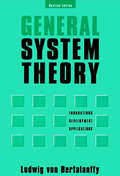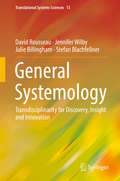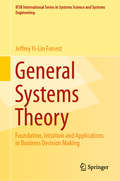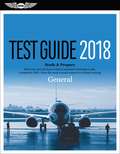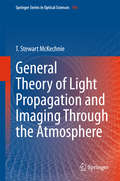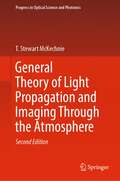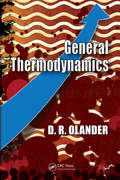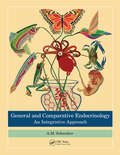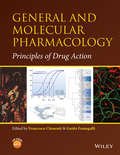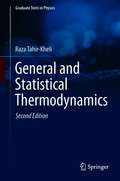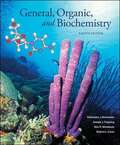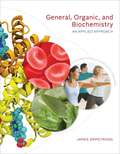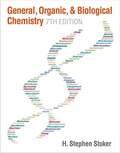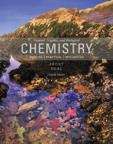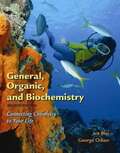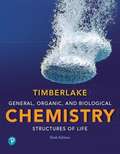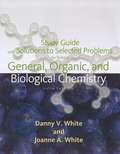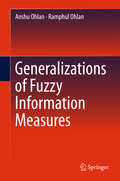- Table View
- List View
General Science (2nd Edition)
by Lucy Jane BledsoeThis textbook contains unit lessons on What is Science?, Life Science, Physical Science and Earth Science.
General Science (Semester 1 and 2) class 7 - Andhra Pradesh Board
by State Council of Educational Research and Training Andhra PradeshThis book has 2 semesters. Each semester have 6 chapters. Pupels will be able to understand the concepts of Keywords, improve your learning, Activities and projectworks.
General Science (Semester 1 and 2) class 7 - Andhra Pradesh Board: జనరల్ సైన్స్ (సెమిస్టర్ 1 మరియు 2) క్లాస్ 7 - ఆంధ్రప్రదేశ్ బోర్డ్
by State Council of Educational Research and Training Andhra Pradeshఈ పుస్తకం లో 2 సెమిస్టర్లు కలవు. ఒక్కో సెమిస్టరు లో 6 యూనిట్లు వున్నాయి. పిల్లలు నేర్చుకోవాల్సిన ముక్యమైన అంశాలు కీలక పదాలు,అభ్యసనను మెరుగు పరుచుకుందాం, ప్రశ్నలకు జవాబులు రాయడం, కృత్యాలు మరియు ప్రాజెక్టు పనులు.
General Science -Civil service- Competitive Exam
by Indic TrustThis is a compilation of questions answer of General Science For Civil Services Competitive Examinations.
General Science class 6 - Andhra Pradesh Board
by State Council of Educational Research and Training Andhra PradeshThis book has 12 chapters. Pupils will be able to focus on Activities, Do you know,Think and discuss,keywords and improve your learning. Teachers give projects to students for improving knowledge.
General System Theory: Foundations, Development, Applications
by Ludwig Von BertalanffyGathered here are Ludwig von Bertalanffy's writings on general systems theory, selected and edited to show the evolution of systems theory and to present it applications to problem solving. An attempt to formulate common laws that apply to virtually every scientific field, this conceptual approach has had a profound impact on such widely diverse disciplines as biology, economics, psychology, and demography.
General Systemology: Transdisciplinarity For Discovery, Insight, And Innovation (Translational Systems Sciences #13)
by Jennifer Wilby David Rousseau Julie Billingham Stefan BlachfellnerThis book expands the foundations of general systems theory to enable progress beyond the rich heuristic practices available today. It establishes a foundational framework for the development of scientific transdisciplinary systems principles and shows how these can amplify the potential of individuals and teams working in multi-, inter- and transdisciplinary contexts or striving to translate their progress across disciplinary boundaries. Three general scientific systems principles are presented, and their relevance to the design, analysis, management and transformation of systems is explored. Applying lessons from the history and philosophy science, this book disambiguates key concepts of general systemology, clarifies the role of general systemology within the field of systemology, and explains how general systemology supports other forms of transdisciplinarity. These insights are used to develop new perspectives, strategies and tools for addressing long-standing challenges to the advancement and transdisciplinary application of general insights into the nature of complex systems.The material presented in this book includes comprehensive models of the structure of systemology as a disciplinary field, the structure and significance of the general systems worldview, and the role of general systemology as the heart of systems science, systems engineering and systems practice. It explains what a fully-fledged general theory of systems would look like, what its potential is, what routes are available to us to develop it further, and how to leverage the knowledge we have attained so far. Many examples and analogies show how general systemology has the potential to enable scientific discovery, insightful theory building, and practical innovation in all the disciplines as they study, design, nurture or transform complex systems. This book is essential reading for anyone wishing to master the concepts, terminology, models and strategies needed to make effective use of current general systems knowledge and to engage in the further development of the philosophy, science, and practice of general systemology.
General Systems Theory: Foundation, Intuition And Applications In Business Decision Making (Ifsr International Series In Systems Science And Systems Engineering Ser. #32)
by Jeffrey Yi-Lin ForrestThis book demonstrates the theoretical value and practical significance of systems science and its logic of thinking by presenting a rigorously developed foundation—a tool for intuitive reasoning, which is supported by both theory and empirical evidence, as well as practical applications in business decision making. Following a foundation of general systems theory, the book presents an applied method to intuitively learn system-sciences fundamentals. The third and final part examines applications of the yoyo model and the theoretical results developed earlier within the context of problems facing business decision makers by organically combining methods of traditional science, the first dimension of science, with those of systems science, the second dimension, as argued by George Klir in the 1990s. This text would benefit graduate students, researchers, or practitioners in the areas of mathematics, systems science or engineering, economics, and business decision science.
General Test Guide 2018: Pass Your Test And Know What Is Essential To Become A Safe, Competent Amt From The Most Trusted Source In Aviation Training
by A. S. A. Test ASA Test Prep BoardThe Fast Track Series is designed to prepare applicants who are seeking Federal Aviation Administration (FAA) certifications for the full range of material on each test of the series. Prospective test takers are supplied with questions that have been used in the FAA's knowledge exams for aviation mechanics along with an answer key, explanations, and references to quickly improve their comprehension and retention of the test and study materials. Learning Statement Codes (LSC) are also included, enabling students to easily interpret which subject areas are indicated as needing further study on their knowledge test reports. This volume of the series deals with the "General" section of the FAA Knowledge Requirements for Aviation Maintenance Technicians.
General Theory of Light Propagation and Imaging Through the Atmosphere
by T. Stewart MckechnieThis book lays out a new, general theory of light propagation and imaging through Earth's turbulent atmosphere. Current theory is based on the - now widely doubted - assumption of Kolmogorov turbulence. The new theory is based on a generalized atmosphere, the turbulence characteristics of which can be established, as needed, from readily measurable properties of point-object, or star, images. The pessimistic resolution predictions of Kolmogorov theory led to lax optical tolerance prescriptions for large ground-based astronomical telescopes which were widely adhered to in the 1970s and 1980s. Around 1990, however, it became clear that much better resolution was actually possible, and Kolmogorov tolerance prescriptions were promptly abandoned. Most large telescopes built before 1990 have had their optics upgraded (e. g. , the UKIRT instrument) and now achieve, without adaptive optics (AO), almost an order of magnitude better resolution than before. As well as providing a more comprehensive and precise understanding of imaging through the atmosphere with large telescopes (both with and without AO), the new general theory also finds applications in the areas of laser communications and high-energy laser beam propagation.
General Theory of Light Propagation and Imaging Through the Atmosphere (Progress in Optical Science and Photonics #20)
by T. Stewart McKechnieThis 2nd edition lays out an updated version of the general theory of light propagation and imaging through Earth’s turbulent atmosphere initially developed in the late ‘70s and ‘80s, with additional applications in the areas of laser communications and high-energy laser beam propagation. New material includes a chapter providing a comprehensive mathematical tool set for precisely characterizing image formation with the anticipated Extremely Large Telescopes (ELTS), enabling a staggering range of star image shapes and sizes; existing chapters rewritten or modified so as to supplement the mathematics with clearer physical insight through written and graphical means; a history of the development of present-day understanding of light propagation and imaging through the atmosphere as represented by the general theory described. Beginning with the rudimentary, geometrical-optics based understanding of a century ago, it describes advances made in the 1960s, including the development of the ‘Kolmogorov theory,’ the deficiencies of which undermined its credibility, but not before it had done enormous damage, such as construction of a generation of underperforming ‘light bucket’ telescopes. The general theory requires no a priori turbulence assumptions. Instead, it provides means for calculating the turbulence properties directly from readily-measurable properties of star images.
General Thermodynamics
by Donald OlanderBecause classical thermodynamics evolved into many branches of science and engineering, most undergraduate courses on the subject are taught from the perspective of each area of specialization. General Thermodynamics combines elements from mechanical and chemical engineering, chemistry (including electrochemistry), materials science, and biology to present a unique and thorough treatment of thermodynamics that is broader in scope than other fundamental texts.This book contains classroom-tested materials designed to meet the academic requirements for students from a variety of scientific and engineering backgrounds in a single course. The first half focuses on classical concepts of thermodynamics, whereas the latter half explores field-specific applications, including a unique chapter on biothermodynamics. The book’s methodology is unified, concise, and multidisciplinary, allowing students to understand how the principles of thermodynamics apply to all technical fields that touch upon this most fundamental of scientific theories. It also offers a rigorous approach to the quantitative aspects of thermodynamics, accompanied by clear explanations to help students transition smoothly from the physical concepts to their mathematical representations. Each chapter contains numerous worked examples taken from different engineering applications, illustrations, and an extensive set of exercises to support the material. A complete solutions manual is available to professors with qualifying course adoptions.
General and Comparative Endocrinology: An Integrative Approach
by A.M. SchreiberGeneral and Comparative Endocrinology: An Integrative Approach, takes a holistic approach to endocrinology, introducing students to the diverse facets of this interdisciplinary science ranging from the medical to comparative domains, while also exploring evolutionary, environmental, and conservation specializations within the field. The textbook is founded on the principle that students interested in the health sciences will benefit from understanding how proficiency in endocrine function among a diversity of organisms contributes to advances in modern medicine. Likewise, students intrigued by comparative physiology will benefit from the wealth of knowledge derived from medical/clinical endocrinology, the historical bedrock of the field. This textbook represents the modern field of endocrinology in its totality by addressing topics and recent advances not currently discussed in other introductory endocrinology textbooks. Key Features Introduces the broad and interdisciplinary scope of endocrinology. Provides clear chapter objectives and key concepts. Includes summary and synthesis questions for each chapter that are suitable for exams and quizzes. Includes a chapter devoted to endocrine-disrupting chemicals. Describes the roles played by the endocrine system in important health challenges related to appetite regulation, obesity, diabetes, and other diseases stemming from ‘mismatches to modernity’. Integrates evolutionary and comparative approaches to hormones and health.
General and Molecular Pharmacology
by Francesco Clementi Guido FumagalliWith a focus on functional relationships between drugs and their targets, this book covers basic and general pharmacology, from a cellular and molecular perspective, with particular attention to the mechanisms of drug action - the fundamental basis for proper clinical use- without neglecting clinical application, toxicology and pharmacokinetics. * Covers cell and molecular pharmacology, bringing together current research on regulation of drug targets, at a level appropriate for advanced undergrad and graduate students * Discusses the relevance of pharmacokinetics and drug development for the clinical application of drugs * Presents material from the perspective of drug targets and interaction, the theoretical basis of drug action analysis, and drug properties * Focuses on structure-function relationships of drug targets - informing about their biochemical and physiologic functions and experimental and clinical pathways for drug discovery and development * Has a companion website that offers a host of resources: short additional chapters about methodology, topics at the forefront of research, all figures and tables from the book, and Power Point slides
General and Statistical Thermodynamics (Graduate Texts in Physics)
by Raza Tahir-KheliThis textbook provides comprehensive information on general and statistical thermodynamics. It begins with an introductory statistical mechanics course, deriving all the important formulae meticulously and explicitly, without mathematical shortcuts. In turn, the main part of the book focuses on in-depth discussions of the concepts and laws of thermodynamics, van der Waals, Kelvin and Claudius theories, ideal and real gases, thermodynamic potentials, phonons and all related aspects. To elucidate the concepts introduced and to provide practical problem-solving support, numerous carefully worked-out examples are included. The text is clearly written and punctuated with a number of interesting anecdotes. The book also provides alternative solutions to problems and second equivalent explanations of important physical concepts. This second edition has been expanded to cover the foundations of superconductivity with new chapters on Cooper pairs, the Bogoliubov transformation, and superconductivity. It is suitable as a main thermodynamics textbook for upper-undergraduate students and provides extensive coverage, allowing instructors to ‘pick and choose’ the elements that best match their class profile.
General, Organic And Biochemistry
by Katherine J. Denniston Joseph J. Topping Kim R. Woodrum Robert L. CaretThe eighth edition of General, Organic, and Biochemistry is designed to help undergraduate health-related majors, and students of all other majors, understand key concepts and appreciate the significant connections between chemistry, health, disease, and the treatment of disease. This text continues to strike a balance between theoretical and practical chemistry, while emphasizing material that is unique to health-related studies. The text has been written at a level intended for students whose professional goals do not include a mastery of chemistry, but for whom an understanding of the principles and practice of chemistry is a necessity. Designed for the one- or two-semester course, this text has an easy-to-follow problem-solving pedagogy, vivid illustrations, and engaging applications.
General, Organic, And Biochemistry: An Applied Approach
by James ArmstrongFocusing on key topics important in allied health and nursing careers, this engaging book is ideal for readers who have had no prior exposure to chemistry. Emphasizing problem-solving techniques, the book takes the most direct path to biomolecules and metabolic processes, provides a wealth of worked examples to help readers understand key chemical concepts, includes novel and relevant "Health Notes" in the margins, and weaves biological and medical applications throughout.
General, Organic, And Biological Chemistry
by H. Stephen StokerSucceed in chemistry with GENERAL, ORGANIC, AND BIOLOGICAL CHEMISTRY'S clear explanations, engaging visual support, and easy usability. Ideal for allied health majors, this Seventh Edition emphasizes the applications of chemistry. Early chapters focus on fundamental chemical principles while later chapters build on the foundation of these principles, developing the concepts and applications central to organic and biological chemistry. Mathematics is introduced at point-of-use and only as needed.
General, Organic, And Biological Chemistry
by Karen C. Timberlake Laura D. Frost S. Todd DealFrost and Deal's General, Organic, and Biological Chemistry gives students a focused introduction to the fundamental and relevant connections between chemistry and life. Emphasizing the development of problem-solving skills with distinct Inquiry Questions and Activities, this text empowers students to solve problems in different and applied contexts relating to health and biochemistry. Integrated coverage of biochemical applications throughout keeps students interested in the material and allow for a more efficient progression through the topics. Concise, practical, and integrated, Frost's streamlined approach offers students a clear path through the content. Applications throughout the narrative, the visual program, and problem-solving support in each chapter improve their retention of the concepts and skills as they master them. General, organic, and biological chemistry topics are integrated throughout each chapter to create a seamless framework that immediately relates chemistry to students' future allied health careers and their everyday lives.
General, Organic, and Biochemistry
by McGraw-Hill CreateGeneral, Organic, and Biochemistry Custom Edition
General, Organic, and Biochemistry: Connecting Chemistry to Your Life
by George Odian Ira BleiGeneral, Organic and Biochemistry is praised for the way it gives students the tools they need to develop a working understanding of chemical principles—rather than just asking them to memorize facts. The new edition brings forward the same clear explanations, quality problem-solving support, helpful pedagogy, and applications coverage, adding new features and content to make the text even more accessible, effective, and relevant to its student audience.
General, Organic, and Biological Chemistry: Structures of Life
by Karen TimberlakeGeneral, Organic, and Biological Chemistry: Structures of Life engages students by helping them see the connections between chemistry, the world around them, and future health-related careers. Known for its friendly writing style, student focus, robust problem-solving pedagogy, and engaging health-related applications, the text prepares students for their careers. The text breaks chemical concepts and problem solving into clear, manageable pieces to ensure students stay on track and motivated throughout their first, and often only, chemistry course. <p><p> With the newly revised 6th Edition, best-selling author Karen Timberlake and new contributing author MaryKay Orgill connect chemistry to real-world and career applications. Their goal is to help students become critical thinkers by understanding scientific concepts that will form a basis for making important decisions about issues concerning health and the environment and their intended careers. <p> The new edition introduces more problem-solving strategies, more problem-solving guides, new Analyze the Problem with Connect features, new Try It First and Engage features, conceptual and challenge problems, and new sets of combined problems—all to help students develop the problem-solving skills they’ll need beyond the classroom.
General, Organic, and Biological Chemistry: Study Guide with Solutions to Selected Problems (5th Edition)
by H. Stephen StokerThe purpose of this study guide is to help students in the study of the textbook, General, Organic, and Biological Chemistry, by H. Stephen Stoker, by providing summaries of the text and additional practice exercises.
Generalizations of Fuzzy Information Measures
by Anshu Ohlan Ramphul OhlanThis book develops applications of novel generalizations of fuzzy information measures in the field of pattern recognition, medical diagnosis, multi-criteria and multi-attribute decision making and suitability in linguistic variables. The focus of this presentation lies on introducing consistently strong and efficient generalizations of information and information-theoretic divergence measures in fuzzy and intuitionistic fuzzy environment covering different practical examples. The target audience comprises primarily researchers and practitioners in the involved fields but the book may also be beneficial for graduate students.
Generalized Adjoint Systems
by Demetrios SerakosThis book defines and develops the generalized adjoint of an input-output system. It is the result of a theoretical development and examination of the generalized adjoint concept and the conditions under which systems analysis using adjoints is valid. Results developed in this book are useful aids for the analysis and modeling of physical systems, including the development of guidance and control algorithms and in developing simulations. The generalized adjoint system is defined and is patterned similarly to adjoints of bounded linear transformations. Next the elementary properties of the generalized adjoint system are derived. For a space of input-output systems, a generalized adjoint map from this space of systems to the space of generalized adjoints is defined. Then properties of the generalized adjoint map are derived. Afterward the author demonstrates that the inverse of an input-output system may be represented in terms of the generalized adjoint. The use of generalized adjoints to determine bounds for undesired inputs such as noise and disturbance to an input-output system is presented and methods which parallel adjoints in linear systems theory are utilized. Finally, an illustrative example is presented which utilizes an integral operator representation for the system mapping.

